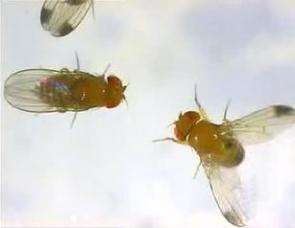On a fly’s wing, scientists tally evolution's winners and losses

A team of scientists from the Howard Hughes Medical Institute at the University of Wisconsin-Madison have revealed the discovery of the molecular mechanisms that allow animals to switch genes on or off to gain or lose anatomical characteristics.
Evolution has always been a game of wins and losses.
Anatomical features, scientists know, come and go. The animal kingdom is full of critters that have independently gained or lost similar features. Whales and snakes, for instance, have lost their legs. Winged flight evolved separately in birds, bats and pterosaurs at different times in evolutionary history.
Now, writing in the April 20 issue of the journal Nature, a team of scientists from the Howard Hughes Medical Institute (HHMI) at the University of Wisconsin-Madison, reveal the discovery of the molecular mechanisms that allow animals to switch genes on or off to gain or lose anatomical characteristics.
"Evolution can and does repeat itself," says Sean B. Carroll, a UW-Madison genetics professor and senior author of the new Nature report that describes how males of different fruit fly species have independently gained — and repeatedly lost — the wing spots that make them appealing to females.
"These spots have appeared and disappeared independently in different species at different times over the course of evolutionary history, and have been junked at least five times in one particular group," says Benjamin Prud'homme, a UW-Madison postdoctoral fellow working in Carroll's lab and the lead author of the new study. "We have shown that each of these transitions corresponds with changes in how a certain gene is used."
The new study reveals how evolution occurs at the finest level of detail and explains the molecular mechanisms at work when animals lose or gain features. In the fruit fly, a gene known as "yellow" is responsible for the fly's wing decoration.
"The gene is like a paintbrush," says Carroll. "But it needs instructions as to where to paint. Little switches embedded in DNA around the gene have the instructions. It is these switches that are evolving. The fly can lose a spot because of a very small change in his spot switch."
Known as "regulatory elements," the switches that govern gene activity are DNA sequences that act like toggles to turn genes on or off. Individual genes can have several switches, Carroll notes, each one devoted to controlling the gene in a different tissue or body part.
In the case of fruit flies, the changes in the switches' activity are driven by the preferences of females. The flies meet on flowers and the male fly — to put the female in the mood — waves his wings and displays his conspicuous wing spots.
"Female preference is a strong force in the evolution of anatomy," explains Prud'homme. "This phenomenon — sexual selection — is all over the animal kingdom. It was one of Darwin's great ideas."
Finding the same gene and the same processes at work — molecular switch evolution — in two distantly related species of fly is remarkable, according to Carroll, because it shows how and why evolution repeats itself.
"The funny thing is they came up with the same solution," Carroll says. "The big picture is that we are seeing the repetition of evolution — in animals widely divergent in time and space — at several key levels."
In addition to Carroll and Prud'homme, authors of the Nature paper include Nicolas Gompel of the University of Cambridge; Antonis Rokas, Victoria A. Kassner and Thomas M. Williams of UW-Madison and HHMI; Shu-Dan Yeh and John R. True of Stony Brook University.
Source: University of Wisconsin
















